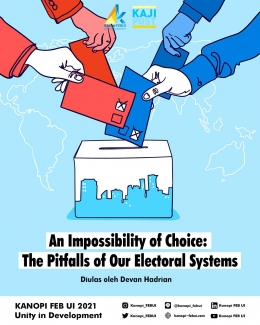Visiting the local polling place and casting our ballots into the box seems like a routine we do every four or five years for most of us living in the developed world. Oftentimes, we just arbitrarily vote for whichever candidate we like the most, and then not think about it too much---maybe until the results are then announced on TV. However, some claim that there are deep underlying flaws within the way we pick our leaders. Dissatisfaction towards executive power and election results is flourishing all over the world. Is there really something wrong about the way we vote and elect our leaders? And more importantly, is there anything we can do to correct it?
The Pragmatic Strategy of Voting
First of all, you might ask: Why is voting and elections a subject of study in economics? At its core, voting and elections deal with the behaviour and choices of people, the same essential concepts that are studied at large by microeconomics. Thus, the technical science of elections can fall under the field of behavioural economics and game theory.
Let us begin by addressing some of the more commonly used voting systems. Most elections oblige the participants to only vote for one candidate, and the candidate with the highest percentage of votes wins the election. This is often called plurality voting, which often takes the form of first-past-the-post elections where only one winner is selected. While regarded as effective, it presents some serious problems. Because there is only one winner, political minorities are usually underrepresented. It is also susceptible to gerrymandering or manipulation of election results by drawing legislative boundaries (ACE, 2021).
Thus, a handful of alternative systems have been devised to replace plurality voting. One such example is the instant runoff voting, otherwise known simply as the "alternative vote". Instead of picking a single candidate, this system allows voters to rank all the candidates from the most to least preferred. The candidate with the least amount of votes will then be eliminated, and their votes transferred to the remaining candidates.
This process continues until a candidate reaches the majority (>50%) of first-choice votes. On the other hand, there is also approval voting, in which voters simply approve or do not approve each candidate, and the candidate with the highest approval wins. Both of these methods are thought to provide results that are more middle-ground and acceptable by the general society, instead of only serving the plurality of voters.
In hindsight, all of these systems should work just fine if there are only two candidates in the election. However, a problem begins to arise when there are more than two candidates. In this situation, sometimes people are incentivised not to vote according to their own preferences, but instead to vote in a way such that the election results will be altered in their favour (Myatt, 2007).
Surprisingly, even with their stark conceptual differences, all three of the aforementioned voting systems are subject to the problem of strategic voting (Primer, 2020). Even with ranked-choice or approval systems, you can still strategically rank a candidate lower or disapprove of them against your preference. So, is there really no solution for this voting dilemma? Or, is there a reason that all of them are equally flawed?
A Paradox of Social Ordering
One of the most fascinating things about elections and voting is the fact that they are actually paradoxical. More precisely, the paradox was first observed by Nicolas de Condorcet, an 18th century French philosopher, and as such it was named the Condorcet voting paradox after him. To understand it, we must first acknowledge that voting is essentially an act of aggregating each voter's individual preferences to form a "social ordering", in which we rank the preference of society towards each candidate.
When we create a rank order of preferences, we surely expect it to be consistent. For example, consider a case where we have three candidates in an election. If most voters prefer candidate A over B, and candidate B over C, then they should also prefer A over C. In economics, this is often called the transitivity principle. Yet our paradox arises as a natural consequence of social ordering itself. Even when the preferences of all voters are consistent, the aggregated social preference, or the voting result, may not be (Condorcet, 1785). Continuing our previous example, suppose we have three voters participating in the election with their respective individual preferences listed below:
Voter 1 prefers candidate A over B over C
Voter 2 prefers candidate B over C over A
Voter 3 prefers candidate C over A over B
As seen above, every voter has a clear transitivity between their choices. The question then becomes: Who should win? Here, we can see that each candidate has the same number of 1st-rank, 2nd-rank, and 3rd-rank votes. If we pick A as a winner, it's clearly a mistake since two out of three people prefer C over A. If we pick C, it also faces the same problem in which two people prefer B over C. So, B should be the winner, right? No, since two people prefer A over B. Essentially, this creates a self-repeating cycle that breaks the transitivity principle, even when all the individual votes are consistent in their preference. Hence, this impossibility of determining collective preferences became a paradox.
Condorcet's groundwork was further expanded upon by the American economist Kenneth Arrow, whose eponymous theorem was published in 1951 under the title "Social Choice and Individual Values". This heavily mathematical theorem, later known as Arrow's impossibility theorem, concluded that it is impossible to formulate the social ordering of an election without breaking one of these conditions (Arrow, 1963):
Nondictatorship (no voter has control over others)
Pareto efficiency (consistency between individual and social preference)
Independence of irrelevant alternatives (removing a losing alternative would not change the election results)
Unrestricted domain (all individual preferences are allowed)
In a way, we can say that these are the conditions for a "perfect" election. However, Arrow showed that regardless of the system being used, any election will inevitably break one of them. Thus, the theorem is often interpreted as stating that no voting system is perfect. While Arrow's mathematical approach is vastly different from what we previously observed, it still reaches the same conclusion that every electoral system has their own pitfalls and shortcomings.
Cherishing Democracy
As meticulously crafted and well-thought out these theorems might be, they still stand atop one of the most widely used pillars of sand in economics: the assumption that everyone will act rationally. For most of us who don't really engage that much in politics, we would probably just vote according to our preferences without considering strategy, and the problem of strategic voting becomes one of less importance. Instead, the problems we encounter with elections are mostly technical problems, such as accessibility, ease of voting, and susceptibility to various forms of fraud. It is more important to address such problems first before we even try to systematically improve our elections.
At the end of the day, democracy is not perfect. Some say that the voice of the people is the voice of God, but most of the time we don't know what the people's voice is. However, that shouldn't stop us from going to the polling place and casting our votes for our favourite candidate. Even with all its flaws, democracy and elections are still the best ways to distribute political power among the people. So go out, vote, and celebrate democracy with all its shortcomings. After all, it's certainly better than being under a dictatorship, right?
Diulas oleh: Devan Hadrian | Ilmu Ekonomi 2020 | Staf Divisi Kajian Kanopi FEB UI 2021
REFERENCES
ACE Electoral Knowledge Network. (2021). Electoral Systems. Retrieved from https://aceproject.org/ace-en/topics/es/
Arrow, K. J. (1963). Social Choice and Individual Values. Yale University Press. ISBN 978-0300013641.
Condorcet, N. d. (1785). Essai sur l'application de l'analyse la probabilit des dcisions: Rendues la pluralit des voix. Paris: De l'Impremiere Royale. Retrieved from https://gallica.bnf.fr/ark:/12148/bpt6k417181
Myatt, D. P. (2007). On the Theory of Strategic Voting. The Review of Economic Studies, 74(1), 255--281. Retrieved from http://www.jstor.org/stable/4123244
Primer. (2020, November 1.) Simulating alternate voting systems. YouTube. Retrieved from https://youtu.be/yhO6jfHPFQU
Baca konten-konten menarik Kompasiana langsung dari smartphone kamu. Follow channel WhatsApp Kompasiana sekarang di sini: https://whatsapp.com/channel/0029VaYjYaL4Spk7WflFYJ2H







